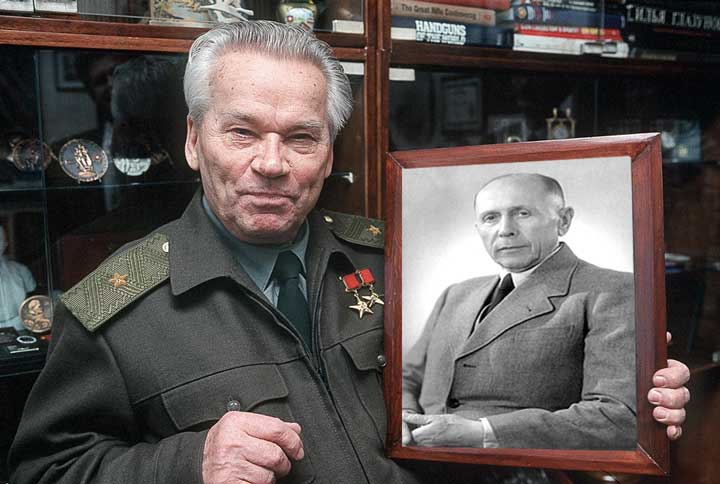According to a common theory, gunsmith Mikhail Kalashnikov, being a poorly educated sergeant, could not invent the famous machine gun. According to one version, the design of the Kalashnikov assault rifle (AK) was copied from the StG 44 assault rifle by Hugo Schmeisser. Another says that the AK was created by Schmeisser himself, who was taken to the USSR after the war. We checked if this is true.
There are many more hypotheses about the appearance of one of the most famous machines, but these two stand out because of their prevalence. In particular, one of the most famous apologists of the first version is historian Boris Sokolov. In an interview with Vladimir Kara-Murza in 2017, he stated:
“I think the main myth is that he created a machine that is named after him. For any foreign specialist in the history of small arms, when he is told the name of Mikhail Kalashnikov as the author of the original machine gun, it evokes a good-natured smile. Because they know such a type of weapon as the 1944 German assault rifle, produced by the design bureau of Hugo Schmeisser. The similarity is extremely great - for different calibers. Actually, the Germans have 7.92, and we have 7.62. In addition, their bolt mechanism is different; it, in turn, was borrowed from Kalashnikov from the American Thompson assault rifle, which, by the way, was not supplied under Lend-Lease, and was known to the Germans as trophies.
Of course, they named the modernization of a German machine gun, an assault rifle from 1944. But in order to make this modernization, you still need to have a higher technical education and know such subjects as higher mathematics and strength of materials. As is known, Kalashnikov did not have a higher education. And there is no evidence that he mastered these disciplines at the level of the institute. So he couldn’t calculate all this.”
The scandal with the Kalashnikov monument in the center of Moscow, which erupted shortly after this interview, added fuel to the fire of conspiracy theorists. Then on the high relief of the newly installed monument a scheme was discovered the same German StG 44. The Russian Military Historical Society, which initiated the installation, promised to dismantle part of the composition, but a wave of ironic comments and reminders of plagiarism could not be avoided. As well as disturbances:

Although the galaxy of designers known in Russia as the “gloomy Teutonic geniuses” had a hand in many important inventions of the mid-twentieth century, it should be noted that neither the StG nor the AK contain any fundamentally new elements of weapon design. The main technical solutions used in them: gas engines, methods of locking the bolt, principles of operation of the firing mechanism and a number of others - have been known since the late 19th - early 20th centuries.
The first samples of StG 44 prototypes: MKb.42(H) and MP43 carbines fell into the hands of the Soviet military in 1943. Based on the results of studying these specimens, as well as the American semi-automatic M1 carbine, meeting On July 15, 1943, the Technical Council under the People's Commissariat of Defense of the USSR raised the question of the need to urgently develop an intermediate cartridge similar to the German one, and, of course, weapons for it.
Pilot production of intermediate cartridge 7.62 x 39 The design of N.M. Elizarov and B.V. Semin began in March 1944. And the first field tests of weapons chambered for the new cartridge were already in April. presented assault rifles of Degtyarev, Simonov, Tokarev, Korovin, Sudaev and Kuzmishchev. The AS-44 designed by Alexey Sudayev was recognized as the best. Unfortunately, the sudden death of the designer interrupted the development of the promising model.
In 1946, a new round of the competition took place. It was attended by designers Rukavishnikov, Bulkin, Dementyev, Korobov and 26-year-old Mikhail Kalashnikov, who since 1942 had worked at the Central Research Site for small arms and mortar weapons of the GAU RKKA.
It is important to note that the prototype developed by Kalashnikov did not have many of the features of the future AK. The principle of operation was a short rather than long stroke of the gas piston, the cocking handle was located on the left, not on the right, instead of a single fuse-translator there were separate flag fuse and fire type translator. The body of the trigger mechanism was folded down and forward on a pin. In the report of a military engineer, senior lieutenant U.I. Pchelintsev, who tested the first sample of the AK-46, it was said: “The system is imperfect and cannot be improved.” However, after additional research, which was carried out at the request of Kalashnikov and, probably, not without the influence of his patrons in the military leadership, Pchelintsev called the AK-46 suitable for further development.
Returning to Kovrov, Kalashnikov, together with the designer of Kovrov Plant No. 2, Alexander Zaitsev, developed an essentially new machine gun. In it, like counts, elements borrowed from other competition participants or previously known solutions were widely used.
Thus, the design of the bolt frame with a rigidly attached gas piston, the layout of the receiver and the placement of the return spring with a guide, the protrusion of which was used to lock the receiver cover, were copied from Bulkin assault rifle. Trigger mechanism - from the Czech self-loading rifle Holek or rifle M1 Garand. The fire mode safety switch lever is very similar to the one used in the Remington Model 8 rifle. And the “hanging” of the bolt group inside the receiver with minimal friction areas and large gaps was typical for the Sudaev assault rifle.
Thus, there is no serious reason to claim that Kalashnikov stole the design from Schmeisser - rather, he used the ideas of his other colleagues, and took a little from each. Moreover, the extent of this borrowing is also disputed website group of companies "Kalashnikov".

As for Schmeisser’s work on the AK directly in the USSR, there are a number of contradictions. Indeed, German specialists were actively involved in the reconstruction of Germany's military-technical achievements for subsequent use in new Soviet developments. And in October 1945, Hugo Schmeisser was involved in the activities of a similar commission at the German plant Simson (formerly Gustloff-Werke), and in October 1946 he agreed to go on a long-term business trip to Izhevsk. He became one of 16 German specialists who worked at plant No. 74 (today Izhmash OJSC).
However, all this time, Kalashnikov carried out his developments in the city of Kovrov and at the Shchurovsky training ground in the Moscow region, almost 1000 km from Izhevsk. In the winter of 1946–1947, Kalashnikov presented an essentially new KBP-580 assault rifle, which had little in common with the previous version, and in March 1948 he arrived in Izhevsk to participate in the development of technical documentation and organize the production of the first pilot batch of the AK-47 assault rifle in the amount of 1,500 units, not at plant No. 74, but at Izhevsk Motor Plant No. 524. How speaks technical consultant of the Kalashnikov concern Vladimir Onokoy, “the machine gun was already ready and even the first batch was released, and all this happened far from Schmeisser, even in theory not giving him a chance to join the work on the weapon.” This information confirms and specialist of the Victory Museum on Poklonnaya Hill Alexander Mikhailov. According to him, none of the Izhevsk designers, especially foreigners, had seen either the machine gun, its designer, or documentation until March 1948. In addition, Mikhailov highlighted a number of serious design differences between the two machines, which do not allow us to talk about copying.
Schmeisser's only participation in the fate of the AK, as a number of authors suggest, could be his contribution to mass production. However, the author of the publication “Hugo Schmeisser in Izhevsk” I. Shaidurov denies this merit too, arguing that according to documents, the Germans helped master the technology only in the production of civilian products, namely motorcycles.
Mostly not true
Read on topic:
1. The birth of the Kalashnikov AK-47 assault rifle.
2. Malimon A. A. Domestic assault rifles (notes of a gunsmith tester), M. Printing house of the Strategic Missile Forces named after. Peter the Great, 1999
3. Small arms developer Dmitry Shiryaev: “The legendary Kalashnikov is not a gunsmith, but a figurehead», “Moskovsky Komsomolets” dated March 1, 2002.
4. Shaidurov I. “Hugo Schmeisser in Izhevsk”.
If you find a spelling or grammatical error, please let us know by highlighting the error text and clicking Ctrl+Enter.







